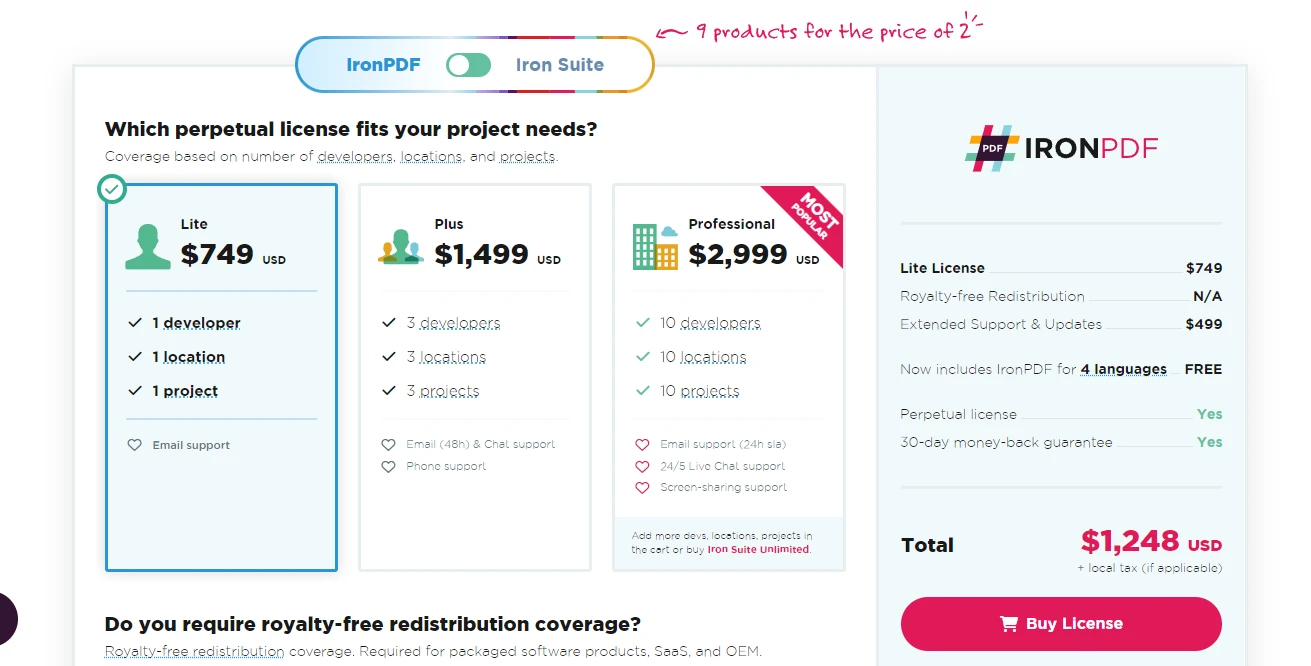Test in production without watermarks.
Works wherever you need it to.
Get 30 days of fully functional product.
Have it up and running in minutes.
Full access to our support engineering team during your product trial
When working with C#, you often need to handle null values, especially with reference types. Nullable types in C# provide a way to represent undefined or absent values for value types. This guide covers the essentials of C# nullable types, their practical uses, and how they work under different scenarios. We'll explore the IronPDF as well later in the article.
By default, value types in C# (e.g., int, bool, DateTime) cannot be assigned null values. To address this limitation, C# introduces nullable value types, allowing you to assign null to value types. Nullable types are particularly useful when you need to represent the absence of a valid value.
To declare a nullable type in C#, you use the following syntax:
// Nullable type variable value
int? nullableInt = null;// Nullable type variable value
int? nullableInt = null;' Nullable type variable value
Dim nullableInt? As Integer = NothingHere, int? is shorthand for Nullable
To check if a nullable type variable has a value or not, you can use the HasValue property or compare the variable directly with null. For example:
if (nullableInt.HasValue)
{
Console.WriteLine("Value: " + nullableInt.Value);
}
else
{
Console.WriteLine("No value assigned.");
}if (nullableInt.HasValue)
{
Console.WriteLine("Value: " + nullableInt.Value);
}
else
{
Console.WriteLine("No value assigned.");
}If nullableInt.HasValue Then
Console.WriteLine("Value: " & nullableInt.Value)
Else
Console.WriteLine("No value assigned.")
End IfAlternatively, you can use the null coalescing operator (??) to provide a default value when the nullable type is null:
int result = nullableInt ?? 0;
Console.WriteLine("Result: " + result);int result = nullableInt ?? 0;
Console.WriteLine("Result: " + result);Dim result As Integer = If(nullableInt, 0)
Console.WriteLine("Result: " & result)If nullableInt is null, the result will be assigned the default value of 0.
In C#, value types (such as int, bool, and double) differ from reference types (like string, object). Nullable value types allow value types to represent null, while nullable reference types allow reference types to be non-nullable by default, thus reducing the risk of null reference exceptions.
A nullable value type allows a value type to take a null value. To declare a nullable value type, append a question mark ? to the data type:
double? nullableDouble = null;double? nullableDouble = null;Dim nullableDouble? As Double = NothingIn this example, nullableDouble can hold a double value or null.
Nullable reference types were introduced in C# 8.0. You enable nullable reference types at the project level or by adding the #nullable enable directive at the beginning of your code file. With nullable reference types enabled, reference types must be explicitly marked as nullable using ?, helping to avoid potential runtime exceptions caused by null references.
#nullable enable
string? nullableString = null;#nullable enable
string? nullableString = null;'INSTANT VB TODO TASK: There is no equivalent to #nullable in VB:
'#nullable enable
'INSTANT VB WARNING: Nullable reference types have no equivalent in VB:
'ORIGINAL LINE: string? nullableString = null;
Dim nullableString As String = NothingHere, nullableString is allowed to be null. If you declare a non-nullable reference type without the ?, the compiler will produce warnings if it detects potential null assignments.
To enable nullable reference types globally in a project, add the following line to your .csproj file:
<Nullable>enable</Nullable>Once enabled, the compiler will treat reference types as non-nullable by default. This feature is especially handy to catch null reference issues at compile time rather than at runtime.
Let’s explore some practical examples to solidify your understanding of nullable types.
In this example, we’ll use a nullable type with int:
class Program
{
static void Main(string[] args)
{
int? nullableInt = null;
int b = nullableInt ?? 10; // Use null coalescing operator
Console.WriteLine("b: " + b);
if (nullableInt.HasValue)
{
Console.WriteLine("nullableInt has value: " + nullableInt.Value);
}
else
{
Console.WriteLine("nullableInt is null");
}
}
}class Program
{
static void Main(string[] args)
{
int? nullableInt = null;
int b = nullableInt ?? 10; // Use null coalescing operator
Console.WriteLine("b: " + b);
if (nullableInt.HasValue)
{
Console.WriteLine("nullableInt has value: " + nullableInt.Value);
}
else
{
Console.WriteLine("nullableInt is null");
}
}
}Friend Class Program
Shared Sub Main(ByVal args() As String)
Dim nullableInt? As Integer = Nothing
Dim b As Integer = If(nullableInt, 10) ' Use null coalescing operator
Console.WriteLine("b: " & b)
If nullableInt.HasValue Then
Console.WriteLine("nullableInt has value: " & nullableInt.Value)
Else
Console.WriteLine("nullableInt is null")
End If
End Sub
End ClassHere, nullableInt is a nullable type variable of int. If nullableInt is null, b gets the value 10 due to the null coalescing operator. Otherwise, b takes the value of nullableInt.
Now, let’s see how nullable reference types work:
#nullable enable
class Program
{
static void Main()
{
string? nullableString = null;
string nonNullableString = "Hello";
Console.WriteLine(nullableString?.Length ?? 0); // Use null coalescing operator
Console.WriteLine(nonNullableString.Length);
}
}#nullable enable
class Program
{
static void Main()
{
string? nullableString = null;
string nonNullableString = "Hello";
Console.WriteLine(nullableString?.Length ?? 0); // Use null coalescing operator
Console.WriteLine(nonNullableString.Length);
}
}'INSTANT VB TODO TASK: There is no equivalent to #nullable in VB:
'#nullable enable
Friend Class Program
Shared Sub Main()
'INSTANT VB WARNING: Nullable reference types have no equivalent in VB:
'ORIGINAL LINE: string? nullableString = null;
Dim nullableString As String = Nothing
Dim nonNullableString As String = "Hello"
Console.WriteLine(If(nullableString?.Length, 0)) ' Use null coalescing operator
Console.WriteLine(nonNullableString.Length)
End Sub
End ClassIn the code above, nullableString can be null, and the null coalescing operator ensures that if it is null, the length of the string defaults to 0.
C# allows you to declare nested nullable types. For example:
int?? nestedNullableInt = null;int?? nestedNullableInt = null;If(Integer, nestedNullableInt) = NothingWhile nested nullable types may seem redundant, they are syntactically valid in C#. However, in practice, nested nullable types don't provide any additional functionality and are rarely used.
The null coalescing operator (??) is frequently used with nullable types to provide a default value when the nullable type is null. This operator simplifies code by avoiding explicit if-else checks.
int? nullableValue = null;
int defaultValue = nullableValue ?? -1;int? nullableValue = null;
int defaultValue = nullableValue ?? -1;Dim nullableValue? As Integer = Nothing
Dim defaultValue As Integer = If(nullableValue, -1)In this example, if nullableValue is null, defaultValue will be assigned -1. Otherwise, defaultValue will take the value of nullableValue.
With nullable reference types enabled, C# produces warnings and errors during compilation when it detects potential issues with null assignments. These compile-time errors help catch issues early, making your code more robust.
Consider the following example:
string? nullableString = null;
string nonNullableString = nullableString; // Compiler warningstring? nullableString = null;
string nonNullableString = nullableString; // Compiler warning'INSTANT VB WARNING: Nullable reference types have no equivalent in VB:
'ORIGINAL LINE: string? nullableString = null;
Dim nullableString As String = Nothing
Dim nonNullableString As String = nullableString ' Compiler warningIn this case, assigning nullableString to nonNullableString produces a compiler warning because nullableString may be null, and assigning it to a non-nullable type could lead to runtime exceptions.

IronPDF is a C# PDF library designed to help developers create, edit, and manipulate PDF files directly from .NET applications. You can convert HTML to PDF, generate reports, or even handle complex document structures.
Nullable types are especially useful in dynamic report generation scenarios, such as when you're generating a PDF for an accountant with incomplete financial data. By using nullable types, you can manage optional fields, avoid exceptions, and provide default values
using IronPdf;
class Program
{
static void Main(string[] args)
{
int? optionalIncome = null; // Nullable type
string? clientName = "Iron Dev"; // Nullable reference type
var renderer = new ChromePdfRenderer();
string htmlContent = $@"
<h1>Financial Report</h1>
<p>Client Name: {clientName ?? "Unknown"}</p>
<p>Income: {optionalIncome?.ToString() ?? "Data not available"}</p>";
var pdf = renderer.RenderHtmlAsPdf(htmlContent);
pdf.SaveAs("FinancialReport.pdf");
Console.WriteLine("PDF Generated Successfully.");
}
}using IronPdf;
class Program
{
static void Main(string[] args)
{
int? optionalIncome = null; // Nullable type
string? clientName = "Iron Dev"; // Nullable reference type
var renderer = new ChromePdfRenderer();
string htmlContent = $@"
<h1>Financial Report</h1>
<p>Client Name: {clientName ?? "Unknown"}</p>
<p>Income: {optionalIncome?.ToString() ?? "Data not available"}</p>";
var pdf = renderer.RenderHtmlAsPdf(htmlContent);
pdf.SaveAs("FinancialReport.pdf");
Console.WriteLine("PDF Generated Successfully.");
}
}Imports IronPdf
Friend Class Program
Shared Sub Main(ByVal args() As String)
Dim optionalIncome? As Integer = Nothing ' Nullable type
'INSTANT VB WARNING: Nullable reference types have no equivalent in VB:
'ORIGINAL LINE: string? clientName = "Iron Dev";
Dim clientName As String = "Iron Dev" ' Nullable reference type
Dim renderer = New ChromePdfRenderer()
Dim htmlContent As String = $"
<h1>Financial Report</h1>
<p>Client Name: {If(clientName, "Unknown")}</p>ignoreignore<p>Income: {If(optionalIncome?.ToString(), "Data not available")}</p>"
Dim pdf = renderer.RenderHtmlAsPdf(htmlContent)
pdf.SaveAs("FinancialReport.pdf")
Console.WriteLine("PDF Generated Successfully.")
End Sub
End Class
In this code, nullable types (int? and string?) are used to handle missing data safely. The null coalescing operator (??) ensures that if any data is missing, a default value is used in the PDF.

Nullable types in C# are a powerful tool for handling null values in both value types and reference types. By using nullable types, you can avoid null reference exceptions and improve the robustness of your code. Remember to enable nullable reference types in new projects to benefit from compile-time error checking, and use the null coalescing operator (??) to simplify your code when dealing with nullable types.
IronPDF offers a free trial to help you explore its features before making a commitment. With no cost upfront, you can test the waters and see how it fits into your development process. Once you're ready to move forward, licenses start from $749.